
| The
textual contents of this site remain © 2013 by Bob Staake.
The art is © 2013 by Karl and Elsie Hubenthal - All Rights
Reserved. No portion of this web site may be used without the
consent of the copyright owners. |
|
|
 
-
| A
Tribute to One of the All-Time Great Cartoonists and Illustrators |
-
-
| HUBENTHAL:
IN HIS OWN WORDS |
-
-
-
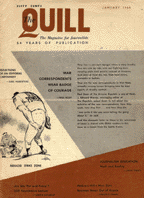
|
|
- Reflections Of An
Editorial Cartoonist
- By Karl
Hubenthal
-
- Originally
published in
'The Quill, The Magazine For Journalists', January 1966.
-
- Ironically,
much of what Hubenthal asserts in this1966 thesis remain valid
and fresh decades after he first penned it. Throughout his career,
Hubenthal staunchly adhered to his personal ideology regarding
how an editorial cartoonist should responsibly approach his craft.
His manuscript is reprinted here, without editing, and with the
same cartoons used to originally illustrate it (BS)
|
-
|
The popular conception (if there
is one) of the newspaper editorial cartoonist pictures him as
an irate crusader, dipping his pen in venom and lashing out in
all directions at the collective bad guys of this world. A sort
of modern Don Quixote, with a permanent madon, continually
tilting at windmills. A talented zany, not entirely reliable,
who devotes his waking hours to deflating balloons or stuffed
shirts.
As a practicing editorial
cartoonist, I am delighted with this opportunity to puncture
a few balloons my-self. The first is that accepted public image.
I submit that such a character never has existed. Any more so
than those "Front
Page" archetypes,
the drunken reporter and the tyrannical city editor. The pressures
of a daily deadline inhibit any flamboyant behavior on the part
of the cartoonist. The mere mechanics of the job leaves little
time for screwball antics. "Four hours of think time and
four hours of drawing" is the general work pattern. Add
to that the hours of reading, researching and waiting for editors
to get off the phone and you have a full work day by anybody's
standards.
|
|
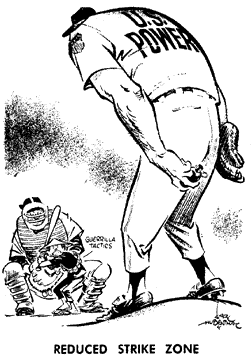 Yet the illusion still persists among editors
and publishers (who should know better) that this ability to
make a concise, to-the-point statement each day, couched in a
clever drawing, is some sort of odd gift that flows from the
cartoonist's head and hand as easily as turning on a spigot.
The complexities of creative writing editors can understand,
because that is their racket. The ordeal of creative drawing...
composition, design, perspective, anatomy..the vehicle we must
use to present this idea we have been polishing for four hours,
is beyond their ken. The suspicion still gnaws at them that somehow
we just "knock it out." The point I am belaboring here
is that every cartoonist I know is a hard working man. Ours is
not the glamourous profession movies and fiction picture it to
be. Yet the illusion still persists among editors
and publishers (who should know better) that this ability to
make a concise, to-the-point statement each day, couched in a
clever drawing, is some sort of odd gift that flows from the
cartoonist's head and hand as easily as turning on a spigot.
The complexities of creative writing editors can understand,
because that is their racket. The ordeal of creative drawing...
composition, design, perspective, anatomy..the vehicle we must
use to present this idea we have been polishing for four hours,
is beyond their ken. The suspicion still gnaws at them that somehow
we just "knock it out." The point I am belaboring here
is that every cartoonist I know is a hard working man. Ours is
not the glamourous profession movies and fiction picture it to
be.
The very nature of his work
habits tends to make the editorial cartoonist a loner and consequently
something of an introvert. He is one of a kind in the city room.
Accepted with considerable suspicion by his fellow journalists
because of this strange marriage of writing and drawing skills.
Oddly, the degree of introversion seems to be in direct reverse
ratio to the inhibitors he loses the moment he takes brush in
hand. The angriest of cartoonists...the Herblocks,
the (Paul) Conrads, the (Frank)
Interlandis...are
the meekest of men, reluctant almost to the point of being anti-social.
Gregariousness is certainly not their long suit.
|
| "It
takes more than just cleverness...You must have something of
substance to say..." |
|
|
It would be wrong to tar all the fraternity
with this "reluctant dragon" brush because of a few
nonjoiners, however. As a past president of the Association of American Editorial
Cartoonists, I
have had occasion to know all 100-odd political cartoonists in
this country on a reasonably intimate basis and I assure you
there is no stereotype for our craft. Their only common denominator
is an aversion to ordered discipline that knows no bounds. Conducting
a business meeting at our annual convention is no mean feat,
believe me. |
|
Nothing sets a cartoonist's
adrenalin to surging so much as that familiar query, "Who
gives you your ideas?" Eccentric we may be, but cartoonists
are also intelligent human beings fully capable of having ideas
of their own. Editors and readers often try to supply us with
ideas but they are seldom, if ever, usable. Largely because these
people do not think in visual terms. It's been my experience
that editors are much too literal-minded to be good idea sources.
When one suggests 10,000 Chinese crossing the Vietnam border,
he actually means draw 10,000 Chinamen all marching. It doesn't
occur to him that one big figure would tell the same story and
be more effective doing it.
Consider a moment what
the cartoonist is asked to provide each day. His must be a unique
comment about the world around him. It cannot be just an illustrated
headline. It must have a personal slant. . . must convey a feeling
about the news that the reader can identify with. This idea must
be presented in an arresting way and at the same time be clean
enough for even the laziest of readers to get the message. Unlike
the columnist, with his generous allotment of space and his easy
access to the "on the other hand" and "according
to current estimate" dodge for avoiding outright commitment,
the cartoonist cannot equivocate. His is a single-shot impact
delivered, hopefully, with a sense of humor.
|
|
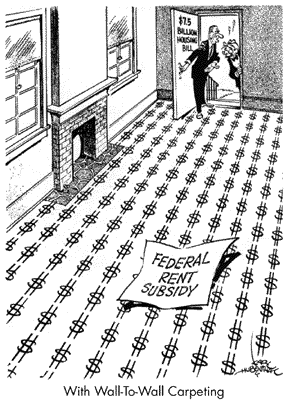 Larger
papers employ an editorial writing staff composed of several
men. Usually each man is sort of an expert in one particular
field. One will be versed in international matters while another
will cover the Washington and political scene. Yet another will
handle the local editorial subjects. However the cartoonist is
expected to know something about everything. He must be prepared
to draw cartoons about international problems, what is going
on in Congress, what's doing in the City Council.. . to speak
knowledgeably about economics, social change, scientific progress.
Add still another factor: Television and the wider use of photography
in newspapers and magazines have made people in the news much
more familiar to readers. Their faces . .their physical characteristics
appear nightly in living rooms throughout the country. Larger
papers employ an editorial writing staff composed of several
men. Usually each man is sort of an expert in one particular
field. One will be versed in international matters while another
will cover the Washington and political scene. Yet another will
handle the local editorial subjects. However the cartoonist is
expected to know something about everything. He must be prepared
to draw cartoons about international problems, what is going
on in Congress, what's doing in the City Council.. . to speak
knowledgeably about economics, social change, scientific progress.
Add still another factor: Television and the wider use of photography
in newspapers and magazines have made people in the news much
more familiar to readers. Their faces . .their physical characteristics
appear nightly in living rooms throughout the country.
Now, when the cartoon incorporates
images of LBJ, Harold
Wilson, Ho
Chi Mihn,
etc., the caricatures must be dead ringers of them. Gone are
the days when you would get by with a poor likeness and a label.
Along that same line, editorial writers and columnists can expound
knowingly about the walk in space with out having the vaguest
idea whether the space capsule hatch hinges on the left or the
right, whether the heat shield is fore or aft. Not so the cartoonist.
Draw it wrong and the observant reader lets you know right now.
Besides reading news releases and background articles, we devote
considerable time to visual research. Ask any cartoonist's wife
about the hours he spends clipping "scrap" for his
reference file.
|
| "The
editorial cartoon is by no means an exclusive American art form...nor
in the view of many are we its best practitioners." |
|
|
The editorial
cartoon is by no means an exclusive American art form, nor did
we originate it, nor in the view of many are we its best
practitioners. The first known drawings of social satire appear
in Egyptian hieroglyphs. The great etcher and painter, Hogarth, raised considerable ruckus in the early 1700s
with his "Rake's
Progress"
and "Gin Alley" series of prints commenting
on the morals of the times. It remained for James Gillray
at the turn of that century to be the first with nerve enough
to involve the British court and the antics of Parliament in
his copper etchings and thus be come the first real political
cartoonist. |
|
It was he who
devised the metaphorical format still commonly used today. His
caricatures started a whole new approach to comic art. It was
he who evolved the symbols of John
Bull, LaBelle France, the Russian Bear, etc. His
excoriation of Napoleon was downright devastating.
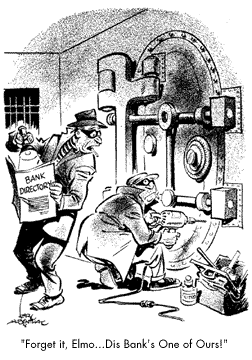 Gillray
was the great, great, great, great grandaddy of our breed in
more ways than one. William
Pitt, an intimate
as well as frequent target of his jibes, described him as "an
example of the imprudence that so frequently accompanies genius
and great talent . . his habits were in the highest degree intemperate".
We gather Jimmy belted it pretty good. Gillray
was the great, great, great, great grandaddy of our breed in
more ways than one. William
Pitt, an intimate
as well as frequent target of his jibes, described him as "an
example of the imprudence that so frequently accompanies genius
and great talent . . his habits were in the highest degree intemperate".
We gather Jimmy belted it pretty good.
Another tippler who
tempered his litho block with absinthe appeared on the scene
in the 1830s. A French man named Honore Daumier. He took Gillray's coarse caricature and developed
it into a fine art. Daumier is the father of the "forceful"
cartoon. His gutsy, vigorous style is inspiration to us yet,
but it got him in plenty of trouble. He managed to spend as much
time in the Bastille as he did blasting Louis-Phillipe or the Second Republic.
His European heirs
today approach the political car- toon quite differently
from their American counterparts. Their style is more contemporary,
lacking the finesse of American draughtsmanship. Their treatment
is more robust, often recoursing to scatological themes we could
never get away with, and always satirical. Satire had never been
the American's dish. Bill
Mauldin has been
quoted as saying, ". . . we (Americans) never really did
have a sense of humor. Not satire, anyway. We're a fatheaded,
cotton-picking society. When we realize finally that we aren't
God's given children, we'll understand satire."
Humor is really laughing
at a hurt, grinning at misery. Much of the naivete of American
cartooning stems from the fact that we have never had to operate
under any form of censorship other than that of our own editors.
There is no jail threat awaiting an anti-De Gaulle,
anti-Menderes, anti-Salazar,
anti-Franco cartoon in the U. S. Strangely,
the country with the greatest state censorship boasts the most
cartoonists. There are 3,500 cartoonists on the 5,000 Soviet
publications (with 30 dailies in Moscow alone.) By comparison
there are 125 or so in the 1,700 U. S. papers. There are about
165 political cartoonists in Western Europe.
|
|
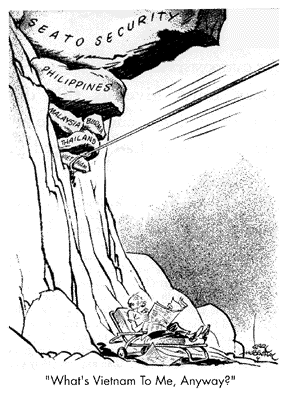
Intellectual critics
have paid much lip service in recent years to the caustic, super-sophisticated,
savage humor type political cartoon. We have several successful
practitioners of that approach, men who boast that they "bring
hate to their drawing board each day," and it's not my purpose
here to knock it. But I do feel they do their newspaper a disservice
by always aiming at a small intellectual segment of the total
readership. I contend that the vast majority of readers are not
sophis ticated, do not read every word in The New York Times, and
do not dig way-out humor. Nothing repulses a reader more than
an inside joke he doesn't comprehend.
I have actually had worldly-wise
newsmen in our city room bring me my competitor's efforts and
ask me to explain whatinell he was driving at. Now that is not
my idea of an effective cartoon, yet obviously some editor thought
it deucedly clever or he wouldn't have okayed it. The incomparable
Herblock, the best in our business
and a good friend of mine, maintains that if only 10 per cent
of his readers get his message that is still a successful cartoon.
I disagree, but Herb certainly has the acclaim to prove his point.
|
| "Poor
taste is offensive even if it is funny." |
|
|
My main
objection to the bitter satire school, I think, is the ugliness
that pervades it both in drawing and in subject matter. There
is no warmth to it. No effort to present anything but a harsh
picture. Poor taste is still offensive even if it is funny. Sarcasm
as a steady diet is not a very palatable dish. I have no quarrel
with subtlety...I think it's an important element of any good
cartoon. My quarrel is with crudity...vindictiveness just for
meanness' sake. |
|
I do not mean to infer
that a good cartoonist
cannot be caustic, even cruel at times ... and it is our job
to arouse the reader's anger as well as his laughter. But it
must be done with responsibility. Being controversial just to
see how many letters to the editor you can get is not responsible
cartooning.
I believe a cartoon
can be witty and funny without being repulsive. There is still
room for the light needle as well as the Sunday punch. Above
all there has to be a conscious effort to relate with your audience
. . . establish an empathy. The cartoonist who considers himself
a superior intellect to his reader is only kidding himself. End
of sermon.
Critical morticians
continue to bemoan the passing of the political cartoon as a
major force in molding public opinion. "There's nobody like
Thomas Nast anymore," they say. "You guys have gone
soft" is the common cry. Baloney! We only remember the past
greats because of their one high moment in history. Homer Davenport battling Mark Hanna
and the trusts, Cesare and the Kaiser, Rollin Kirby ridiculing the Volstead Act with his figure
of Prohibition, Ding
Darling fighting
for conservation, Ed
Duffy belting the
Ku Klux Klan, Daniel Fitzpatrick fulminating against the Nazis. But, look at
their daily output over the years and you will be absolutely
astonished at the stacks of puerile pap they ground out ...every
one of them! There is a greater percentage of really good cartoonists
working in this country today and a lesser per centage of trite
cartoons being produced than at any time in the history of journalism.
There are at least 10 cartoonists drawing today who could shoulder
the mantle of any of the gentlemen mentioned here. It's the
old story: Joe
Louis would have
killed Jack Dempsey,
and Muhammad
Ali-Clay would
murder Louis with those fast hands. The old legends die hard.
|
|
The Editorial
Cartoonist's Prayer:
'Dear Lord,
give us this day our daily idea, and forgive us for the one we
had yesterday.'
|
|
|
It appears
to me that it's not the cartoonist that has changed so much as
the world and subjects he deals with. Possibly the issues of
yesterday were more clear- cut than the involved diplomatic decisions
of the Atomic Age, but that doesn't mean the cartoonist's lance
has been dulled in the process. We put the blast on a LBJ or
a DeGaulle with a vigor equal to any of our predecessors. Communism
and atomic annihilation are greater menaces to be warned about
than anything they ever dealt with. None of us backed away from
commenting on the Civil Rights struggle . . . many contributing
statements that make Duffy's Ku Klux Klan cartoons pale by comparison.
There is no noticeable lack of conviction in cartoons today. |
|
Like everywhere
else, publishers too have changed. The old breed of fire eater has become almost
extinct. There was a time when editors and publishers
alikewere all out for swinging an editorial haymaker. Newspapers
are too big a business now and there are too many toes that can
be accidentally stepped on to leave much room for swinging. The
ineffective cartoonist is quick to blame his own inadequacy on
the restrictions laid upon him by his publisher. But that safe
out is rapidly being denied him. More and more over the country,
cartoonists are being given the same freedom publishers extend
to their columnists. The cartoon is be coming a feature unto
itself, not necessarily tied into an editorial, and in some instances
even expressing a view in opposition to the paper's policy, though
that is a rare occurence. Editors and publishers are discovering
that and they get better results allowing their cartoonists elbow
room to express his own
opinions. After all, a cartoon is a bylined feature. The cartoonist
signs his name to every statement he makes for publication.
Obviously he must stay within a loose framework of general policy.
The working arrangement could not be a very satisfactory one
if the publisher and his cartoonist did not share reasonably
the same view on most subjects.
Happily, in my own
case, I have always generally agreed with the policies of the
Hearst papers. There has never been any conflict serious enough
for me to feel I must argue the point. The man who hires
you has the right to respect for his opinions if not the right
to force them on
you. I can honestly say that in the 10 years I have been the
full-time editorial cartoonist for the Herald-Examiner and the other Hearst newspapers, I have never
once been told what to draw, or even what subject matter to concentrate
on. Only rarely do I have an idea rejected. Such confidence is
flattering but the responsibility that accompanies it is an awesome
burden indeed.
|
|
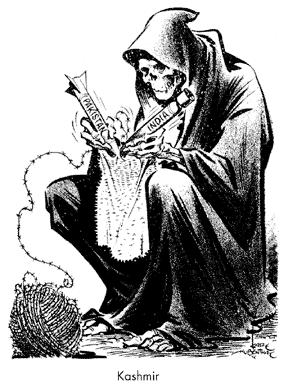 President
Johnson summed it up pretty well recent ly in a nationally televised
speech before the Association
of American Editorial Cartoonists in the East Room of the White House. "I
know that I am talking to the most influential journalists in
America," he said. "Reporters may write and politicians
may talk, but what you draw remains in the public memory long
after these other words are forgotten." President
Johnson summed it up pretty well recent ly in a nationally televised
speech before the Association
of American Editorial Cartoonists in the East Room of the White House. "I
know that I am talking to the most influential journalists in
America," he said. "Reporters may write and politicians
may talk, but what you draw remains in the public memory long
after these other words are forgotten."
Admittedly, the cartoonist's
job is a hard one, entailing long hours and considerable mental
anguish, but none of us would ever trade. The chance to speak
your mind each day before several million people is an opportunity
not given to every man. It takes more than just cleverness to
hold those people's attention. You must have something of substance
to say. And say it with conviction.
I learned long ago
to reject the first idea that crops up as my work day starts
each morning. I force myself to dig for that second, third or
fourth angle on a given subject. As the daily deadline draws
closer and closer, the panic compounds itself but that one better
idea is always there if one digs hard enough for it. Cartoonists'
allegiances and motivations may differ but we all share a common
working prayer. It goes like this: "Dear Lord, give us this day our daily
idea, and forgive us the one we had yesterday."

Karl
Hubenthal
Los
Angeles, California
1966
|
|

